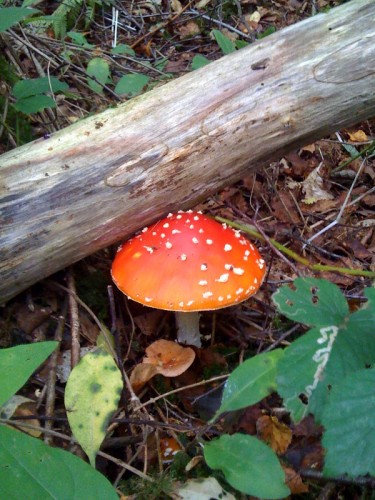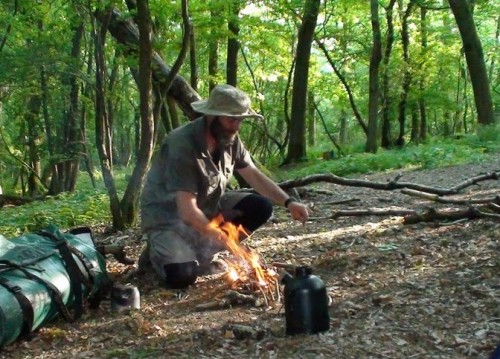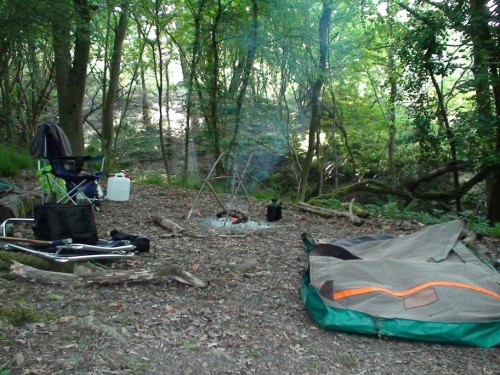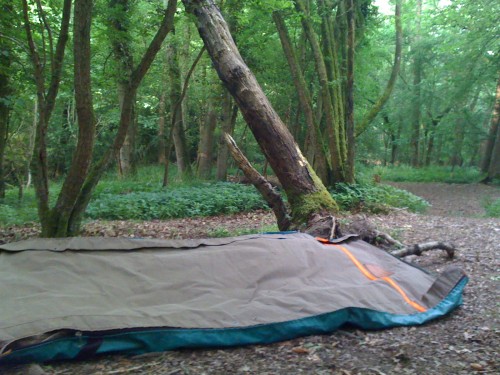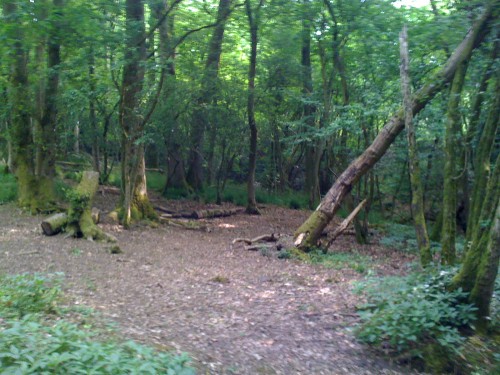Mid way through September and the Fungi season is well under way. A walk in your local woodland should reveal some fantastic shapes and colours as the ‘mushrooms’ pop up all over the place. Here’s a fantastic ‘Fly Argaric’ the classic ‘toadstool’ – Thanks to Jorge for sending this photo in.
Category Archives: Canoeing and Bushcraft
Canoe & Tarp Set up
Top tip is put it up as soon as you arrive in light so you got immediate shelter to retreat to. Dont wait for the 3am rain! And be creative with resources available if difficult location. Bear in mind prevailing wind direction and where the fire smoke will go. Don’t put it right where the cattle are coming down to drink or you could get trampled on in the dark. Check any rising water potential. If electrical storm comes and you are exposed in the open you need a contingency plan for where to go. Refer to advice on being exposed in thunderstorms. Here’s some photos of my last trip using the canoe and tarp rig:
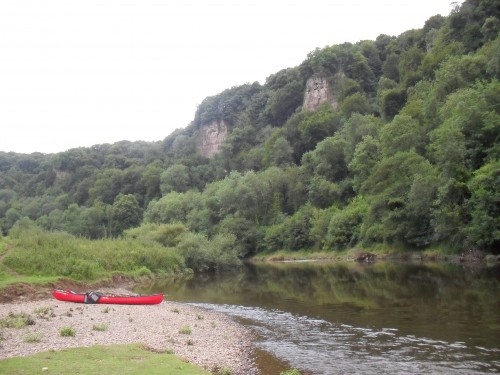
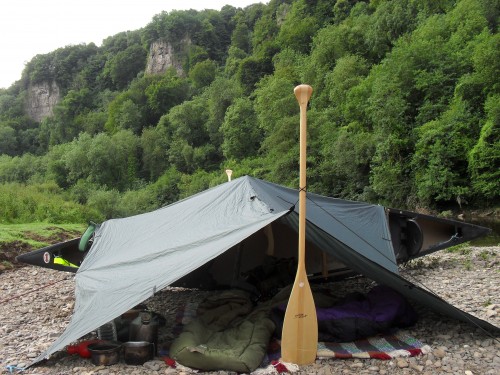
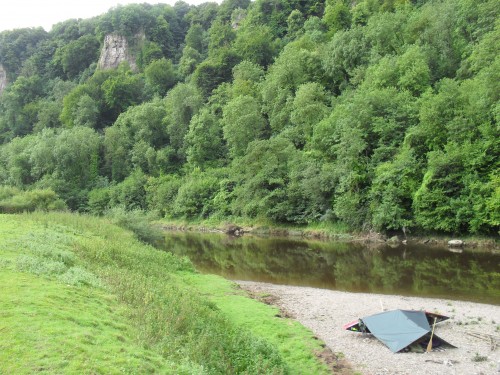
Good Ol’ Kelly Kettle
You’ll see the Kelly Kettle and Eydon STORM Kettle in use all over this site: If you haven’t already got one then we heartily recommend that you become acquianted with this fantastic piece of gear: perfect for river trips and camping. And if you are wondering where you can get one, we’ve provided this selection of Kelly Kettles, Ghilie Kettles and accessories from Amazon.co.uk:
Bushcraft Books
A selection of Bushcraft Books available currently from Amazon.co.uk, including titles from Ray Mears etc.
[carousel keywords=”bushcraft” marketplace=”GB”]
Canoeing Books
A selection of Canoeing Books available currently from Amazon.co.uk:
[carousel keywords=”canoeing” marketplace=”GB”]
Sevylor Colorado Video Review – Part 1 The Setup
Here is the first installment to our Sevylor Colorado video review. This sequence is shortened a little, but even if we include filming, this canoe is river ready in under 15 minutes. Enjoy this video, the full review write up will be coming soon with the boat in action video.
Summer Woodland Camp
With special permission from a woodland reserve owner near Bath in Somerset we were able to have a fantastic summer camp in the middle of thick woodland in early June. The chance to sleep out overnight right amongst the wildlife of a living forest was a fantastic experience, one which really awakens the senses to the richness of nature living in our native woodlands here in the U.K.
For the date we’d chosen we had an unusually hot early summer day with temperatures up to 28 degrees, so the heat in exposed areas was intense, but as we sunk into the woodlands the temperature changed dramatically to a very comfortable, cool temperature with a light breeze rustling through the woods – perfect conditions for our camp-out.
Arriving mid afternoon we spent some time walking around the extensive woods on the reserve getting to know the wildlife and birds and the different types of trees. The reserve consists of some open natural grassland meadows, bordering onto several areas of woodland, which covers the hillside and several quite steep gullies with streams running down the hills. We spotted Speckled Wood butterflies resting in the sunshine – these butterflies are territorial unlike many species – they occupy usually a small patch of sunlight area amongst the woods, and keep that territory for themselves – this means you can often see them in the same spot, if the fly off you can just wait a few moments and they’ll usually be back, unlike most butterflies which often disappear out of sight once you’ve come across them.
After a while we found a lovely camp spot on the edge of one of the gullies -with a nice breeze rolling down the hill to keep the temperature cool, and views throughout the woods and across the gulley to the woodland fringe where it met one of the meadows, a likely spot for deer feeding in the meadow and using the shelter of the edge of the woods.
We returned to the Land Rover to collect our gear, including a couple of Australian “swag” bedrolls, that make perfect beds for sleeping out in woodland, open to the forest around. These aren’t light to carry as they’re made for 4×4 travel, but it was manageable to carry them and a minimal set of other gear including our STORM Kettle (from the Eydon Kettle company) back into the woods to our camp.
We set up the camp around a fireplace, taking care to clear dry leaves and twigs away and go back to bare earth as a preparation. The site was on a fairly steep slope, and to tackle that we placed long timbers horizontally along the slopes, secured with wooden pegs which would mean the swags could rest in a good flat position despite the slope. This worked really well and we were extremely comfortable during the night.
During the evening we were treated to some baby Roe deer with their striped markings wandering along the banks of the gully opposite the camp, feeding on new shoots and leaves. Later a large Roe Stag passed through, letting out large aggressive barking calls as he went.
We saw many species of birds among the woods including woodpeckers and tree creepers. When you stop, and sit quietly in woodland as we were at out camp you see and experience the activity in woodland completely differently and more richly than when walking through, however quietly you are moving.
As dusk fell we made our way through the woods to a badger sett recommended by the staff of the Reserve, which was situated on the opposite bank of a deep gulley meaning we had an excellent viewing position.A viewing platform has been set up by the Centre for badger watching at this area, making it very convenient for the school children and other visitors to the nature reserve to experience one of the great wonders of our native woodlands, an active badger sett.
Within minutes of arriving, just as the light inside the woodland was beginning to fade, there was activity in front of us: white and black striped noses peeked out of some of the holes, sniffing the air. With the wind in front of us, our scent was carried away from the badgers, and as a result they quickly began emerging form their holes in numbers, a bit of scratching first and then some rummaging around around the sett under leaves – breakfast for badgers I guess! It was an incredible and magical sight to see these graceful large animals coming out to start their night out in the forest, unaware of our presence. There’s something quite incredible about these animals when you see them for real in their natural habitat, and you feel absolutely alive and inspired by having the chance to witness it. It’s something many people will never get a chance to do, despite badgers being common in the UK – but they are entirely nocturnal, unlike foxes or deer for example, so unless you get out there in the dark, you just don’t seem them.
After 15 minutes of watching these wonderful creatures we returned to our camp as darkness fell around. We cooked some strips of rump steak on the fire, suspended on skewers made from green hazel twigs (so they don’t burn allowing the meat to cook over the flames). We had sweet potato and large baking potatoes cooked in the embers and then allowed to cool, both fantastic – a simple meal, with no need for plates or cutlery – the potatoes char completely on the outside but the extreme temperature in the embers cooks them through, whilst moisture is trapped inside, making these potatoes completely different and much sweeter than when cooked at home.
Later we heard a rustling in the leaves – something was coming up through the gulley right towards our camp – as we rose up to look, and large badger pushed through the undergrowth to just a few feet away, then stopped, looked up and decided to take another route around the the camp! If we hadn’t got up to look he would have wandered right into our camp and been unaware we were there.
So after a very loud “dusk chorus” from the birds, especially the crows above, the forest finally quietened down, while the bats flitted around through the trees above us, and we retired into the swags for the night – the feeling of sleeping out in an open swag bag in the woods, looking up at the trees above, with a few stars peeking through the leaves, and the sounds and smells of the forest all around is something quite magical, and we were really blessed with the perfect weather and time of year for our camp.
The dawn chorus was a symphony – an amazing experience in itself when you wake up right there in the woods. George (editor of UKWildlife.com) rose early hoping to spot more early birds, and then got the fire woken up again, cooking some bacon and toast on the fire.
After the morning watching the forest come to life, and more deer pass by, we were ready to go and set about the important job of clearing up the camp and the fireplace. We always practice “no trace” camping when camping wild of course, and especially in woodland it’s imperative to manage the camp and fire place, of course to be sure there’s nothing left smouldering, but also as a basic respect to the environment, to the wildlife that lives there and to other users – it must be left as if you were never there, and that’s what we did. So any logs were burnt off completely before we left, then the ash remaining doused and left to cool, then the ash was collected by hand to be sure it had cooled, and scattered over a wide area – ash contains important nutrients particlurlay potassium which is of benefit as long as it’s scattered thinly and not left in a mass where it leaves a negative trace, with nothing able to grow or process the nutrients.
So finally when done we were happy to leave this beautiful place just as we’d found it, after a fantastic night bearing witness to the nature of our wonderful native woodland habitat, a truly magical experience, and one that I aim to repeat regularly from now on whenever possible, and certainly once in each of our seasons, to see the major changes throughout the year.
Woodland Camp
We just got back from a fantastic woodland swag camp in a local nature reserve. Given special permission, we were able to camp in a place not normally open to that activity, surrounded by the sights and sounds of a protected woodland and grassland nature reserve. We were treated to young Roe deer and even a badger wandering past our camp, as well as a large male Roe deer passing by and letting off loud barking calls just outside our camp. We’ll write up the trip in full soon, but here’s a pic of the woodland camp scene – you’ll spot the green Australian “swag” wild-camping bedrolls rolled up in the pics below.
May on The River – Overnight Camp
Took a trip to the River Wye at the end of May with our Australian visitor “OZMan” to show him what it’s like in a country that has rather more water and lush growth than they get down under. A fantastic trip again in gorgeous late spring weather, OzMan even took a dip in the river and climbed tup to the top of Yat Rock, he was really struck by the beauty of our English countryside. I lent him one of our genuine Australian swags so he’d feel right at home! Somewhere along that lazy river as the evening drew in towards dusk I spotted a rare “Hobby” falcon flashing over the surface of the water catching bugs, something I’ve never seen before – a really beautiful bird, with a very distinctive agile flight full of twists and turns as it races after dragon-flies and moths, eating them on the wing. As the canoe drifted silently on the water we came very close, right under a branch where it had stopped to rest for a while, so I could see that striking red underside and dark moustache features. But it’s in flight you want to see this bird – a really magical experience, and one you’d be unlikely to see except from down at the water level in a canoe, approaching silently on the water.
Fire Steel Striker and Birch Bark Technique
A short video sequence showing the technique for fire lighting using birch bark and a steel fire-striker.

